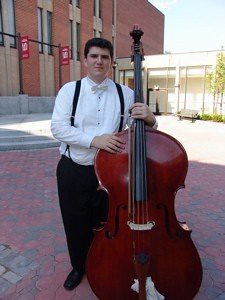This is a post from double bassist from Cincinnati College-Conservatory of Music student Nicholas Hart. Nick will be contributing weekly posts to the bass blog about life as a music student in one of the nation’s most exclusive programs. I think readers will find this different perspective on the double bass world and the music world in general to be quite interesting, and I am looking forward to reading these posts. You will be able to read all of Nick’s contributions under the articles link in the menubar or in the sidebar under contributors. Enjoy!
____________
Spring break is over, not that it was really a break anyway, and I’m back at school for my last quarter of my first year of college. It’s the final stretch and I face a challenge – What can I do so that I play far beyond the level of the year that I am in? My answer is sound.
Sound is such an important aspect to us playing. We can have the great vibrato or intonation, but nobody will ever hear it if our bow is producing a good sound. Another important aspect on sound is realizing that the way the instrument sounds under your ear is nothing like the way it sounds 25 feet away. This is very important when taking auditions. The committee is usually sitting far off in the auditorium and they want to hear a sound that can rumble the walls but also that can be so quiet that they need to strain to hear it.
What few young bassists realize is that every movement, while playing, either directly or indirectly affects your sound. Little things like slouching or sitting as tall as possible, or hanging your weight properly in your left hand, or using your whole body to draw the sound with as little movement as possible. The first two are very obvious. You always want to sit as tall as possible and not slouch, not only for your sound but for the sake of your back, and if your left hand isn’t hanging properly than a clear pitch and sound can’t be produced. But, using your whole body to draw a sound is something that is very complicating and takes years of practice to master.
It is actually a simple idea with difficult concepts. If you draw the sound with just your arm, than your arm is the lever and the fulcrum that is used to produce the sound is your shoulder. But if we want a bigger sound with less work, we have to make the level bigger and move the fulcrum. So, if we make our entire body the lever and our feet the fulcrum, then we now have the biggest lever possible and we are drawing a sound from the floor. So now that we have the simple theory laid out, comes the complex ideas of applying the theory.
The way to do this is by applying horizontal force to the string, similar to that of a pizzicato, instead of vertical force (downward pressure). I would go into it in great detail but I, like my teacher and many other great pedagogues can and have written books just on sound production. The basic idea though is that you want to emulate a pizzicato with your bow. So your sound starts from the floor with a shift in weight from the feet, then your body rocks gently in the direction of the bow, and then the movement of your arm is like a figure eight. This whole time your fingers are drawing circles with the bows, similar to that of the pistons on an old steam train (for us German bowers) and eventually after years of practice, experimentation and perfecting the details we have a good sound.
Sounds simple, but is far from it. And this quarter I want to apply these concepts as best I can, so that my sound is as clean, clear, bassy, and big as possible. Along with a better sound, intonation is easier to hear, and by the end of this school year I want to get my sound and intonation to about 80% consistent. Mr. Laszlo tells us that before we take an audition, our sound, intonation, rhythm and musicality needs to be about 95% consistent and to win a job it needs to about 99% consistent. So to all those aspiring bassists like myself, keep working and become a machine because it’s only getting more competitive out there.
__________________
About the Author
Admitted into the
Bass News Right To Your Inbox!
Subscribe to get our weekly newsletter covering the double bass world.


Yep, sounds like you’re in your first year with Laszlo….
Just stay positive!!!
good luck
Thank you for your post. I find the parts about drawing circles with the bows and keeping consistent being insightful to me. Gosh…looks like I still have quite a way to go.
How can I get a good full sound on theupright bass…using the poly-tone amp and a Sansamp pre-amp?